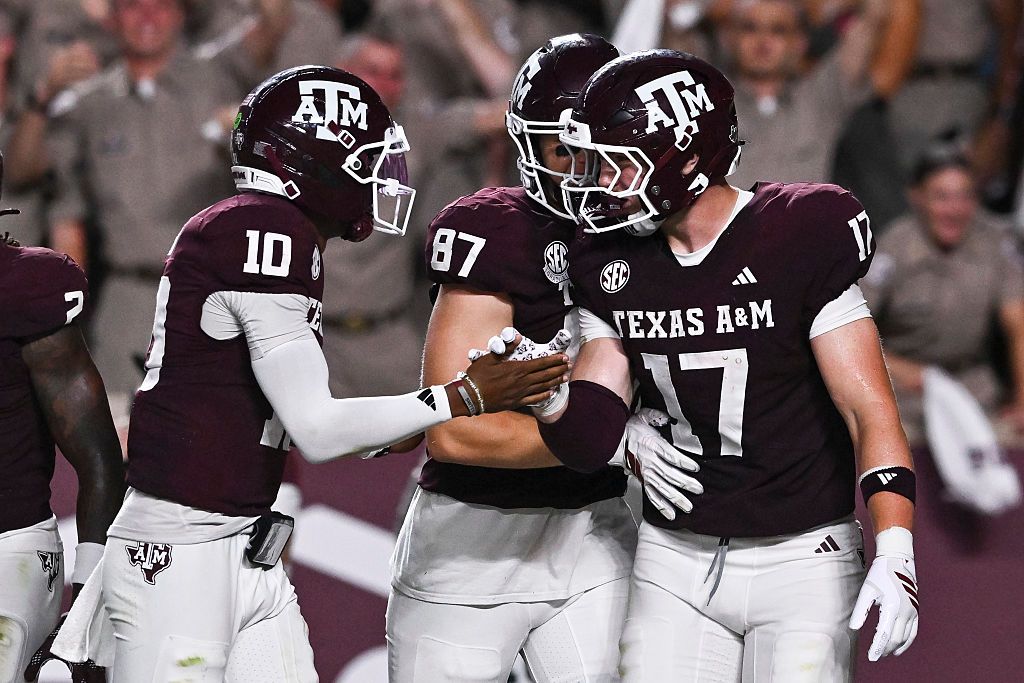This season, I’m breaking down a few of college football's biggest games each week and giving out at least one bet I like from each matchup.
Let’s break down a critical SEC showdown as LSU tries to stick in the playoff race and Texas A&M hopes to remain undefeated.
Texas A&M vs. LSU, current line:
Texas A&M at LSU Best Bet Prediction:
Trust Brian Kelly to get the job done with his back against the wall and bet LSU against the spread.
- Texas A&M vs. LSU, best line: LSU +2.5
» Bet it now at Novig: LSU +2.5 points
When Texas A&M is on Offense
Texas A&M runs a balanced, slow-paced offense under coordinator Collin Klein.
The Aggies rank 92nd in pace of play and, according to Campus2Canton, have a rate 1.2% above expected based on situational data.
Although Klein is slightly favoring the passing attack this year, the run game has always been his calling card, and it’s still what makes this Aggies offense click.
Based on this opponent-adjusted data from Sports Info Solutions, however, LSU’s much-improved defense might be a formidable opponent:
- Texas A&M: ranked 30th in yards before contact
- LSU: ranked 10th in yards before contact allowed
- Texas A&M: ranked 37th in yards after contact allowed
- LSU: ranked 110th in yards after contact allowed
Despite LSU’s success generating early contact, the yards after contact metric might be more critical in this matchup.
Klein likes to use heavy formations, which invite stacked boxes and naturally increase the rate of early contact.
As a result, Aggie running backs have faced seven or more defenders in the box 62% of the time, the 19th highest rate per Sports Info Solutions.
LSU’s defense ranks 19th in early contact rate with a stacked box, but since the Tigers struggle to bring ball carriers down on first contact, they still allow 5.0 yards per attempt with a stacked box, ranking 97th.
Le’Veon Moss and Rueben Owens share the ball in the A&M backfield and have been equally strong running into stacked boxes, as evidenced by these numbers from Sports Info Solutions:
- Moss: 5.0 yards per attempt, 3.0 yards after contact per attempt
- Owens: 5.3 yards per attempt, 2.7 yards after contact per attempt
However, Moss was lost to an injury two weeks ago, which forced E.J. Smith (son of Emmitt Smith) into action.
Smith was effective against a terrible Arkansas defense last week, but the sixth-year senior has been a career backup for a reason.
A productive rushing attack will be critical in this game because A&M’s offensive line will have its hands full with the LSU pass rush, and protecting Marcel Reed is critical to the Aggies’ offensive success.
When facing pressure, Reed excels at avoiding drive-killing mistakes 一 ranks 26th in sack rate versus pressure 一 but he struggles to keep the offense on track.
Reed only ranks 68th in the country and eighth in the SEC in positive EPA rate against pressure, per Sports Info Solutions.
So let’s check out the matchup in the trenches based on these opponent-adjusted numbers from Sports Info Solutions:
- Texas A&M: ranked seventh in pressure rate allowed
- LSU: ranked first in pressure rate generated
Although both units have been strong, the edge probably goes to LSU due to A&M’s tendency to use Reed as a traditional dropback passer.
Reed has taken a dropback of three or more steps 57% of the time (average is 50%), and those dropbacks tend to give the defense more time to create pressure.
LSU has generated a 52% pressure rate against traditional dropbacks, so pressure will be unavoidable, and Reed will need to make plays.
Fortunately for the Aggies, Reed has the skillset to adjust, and a quicker passing attack in this game might be the way to beat LSU’s defense.
Although Reed primarily uses traditional dropbacks, one-step drops and RPOs still account for 33% of his dropbacks, per Sports Info Solutions.
On those one-step drops and RPOs, Reed has been excellent:
- 74% completion rate, ranked 40th
- 8.3 yards per attempt, ranked 18th
- 63% positive EPA rate, ranked 1st
Success on these types of plays is made possible in part due to Reed’s quick processing skills, but also due to his weapons at receiver.
A&M added Mario Craver and KC Concepcion from the transfer portal, and both are perfectly suited for a quick passing attack due to their play-making ability after the catch.
In large part due to the contributions of Craver and Concepcion, A&M ranks eighth in the country in yards after catch per reception (7.4).
LSU’s secondary is much improved this year, but limiting yards after catch has been an area of weakness, as the Tigers’ defense ranks 58th by the same metric.
Partially for this reason, LSU’s defense has been vulnerable to the quick passing game, allowing 6.7 yards per attempt on one-step dropbacks and RPOs, ranked 67th.
So as long as Klein makes the necessary adjustments, A&M should have success negating the LSU pass rush with a quick-strike passing attack.
When LSU is on Offense
LSU offensive coordinator Joe Sloan leans heavily on the passing attack, though not because the unit has been particularly effective.
According to Campus2Canton, the Tigers throw the ball at a rate 12% above expected based on situational data.
The reason for the pass-heavy approach is primarily due to the lack of a rushing attack.
However, Texas A&M’s run defense has not been dominant, and this is an intriguing matchup based on the stark contrast between each team’s strengths and weaknesses.
Let’s take a look at the mismatch in the run game based on opponent-adjusted data from Sports Info Solutions:
- LSU: ranked 105th in yards before contact
- Texas A&M: ranked 26th in yards before contact allowed
- LSU: ranked 20th in yards after contact
- Texas A&M: ranked 106th in yards after contact allowed
Caden Durham is a physical runner, and when hit at or behind the line of scrimmage, he’s averaging 2.8 yards per attempt, the second-best mark in the SEC.
So, Texas A&M’s issues bringing down the ball carrier upon first contact might allow LSU to have some success in this matchup.
It’s also worth noting the Aggies run defense has been particularly poor when forced to line up with a light box 一 and LSU running backs have faced a light box 63% of the time thanks to Sloan’s spread scheme.
Texas A&M is allowing 5.8 yards per attempt with a light box (ranked 87th).
A team with a better rushing attack could exploit that weakness in the Aggies defense, but since LSU leans so heavily on the passing attack, that area of the offense is more likely to decide this game.
Unfortunately for LSU, injuries are likely to play a role in the passing game, as the Tigers lost left tackle Tyree Adams to a sprained ankle last week at Vanderbilt.
Even with Adams in the lineup, LSU was going to have a hard time against the Aggie pass rush, as demonstrated by these opponent-adjusted numbers from Sports Info Solutions:
- LSU: ranked 72nd in pressure rate allowed
- Texas A&M: ranked 11th in pressure rate generated
A&M’s pass rush should have no issues getting to the relatively immobile Garrett Nussmeier due to LSU’s tendency to have him sit in the pocket.
Against traditional dropbacks (which Nussmeier uses 52% of the time), A&M generates a 52% pressure rate, ranked eighth in the nation.
Much like Texas A&M, however, LSU should be able to pivot to a different approach and get the ball out more quickly.
Check out Nussmeier’s numbers on one-step dropbacks and RPOs via Sports Info Solutions:
- 77% completion rate, ranked 29th
- 7.3 yards per attempt, ranked 44th
- 58% positive EPA rate, ranked 14th
Texas A&M’s defense ranks 80th in yards per attempt against one-step dropbacks and RPOs, so this appears to be a weakness LSU can exploit.
Final Thoughts on LSU vs. Texas A&M Best Bets
This is the ideal spot to side with Kelly, so let’s bet on LSU against the spread.
At LSU, Notre Dame, and Cincinnati, Kelly is a combined 13-7 outright as a home underdog with a winning record at each stop.
Although this should be a competitive game and both teams have advantages in certain areas, Kelly’s strong track record in this type of game, coupled with the edge of playing under the lights in Death Valley, makes LSU look like a strong play.


















